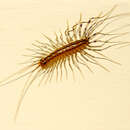en
names in breadcrumbs


S. coleoptrata are very fast moving centipedes. They have a shorter body and longer legs than other species, preventing them from tripping over themselves as they run. Their legs progressively get longer towards the rear of the body. This allows the rear legs to cross the legs in front of them, going above and to the outside, preventing entanglement. The rear-most legs are actually twice as long as the front-most legs.
US Federal List: no special status
CITES: no special status
Immature S. coleoptrata hatch from the egg appearing very similar to the adults, although they have only four pairs of legs. As they develop they pass through five larval instars, with each molt gaining more leg pairs. After their fifth molt, they have all fourteen pairs of legs and are mature.
House centipedes are not aggressive, but can bite people in self-defense. Often their fangs are not strong enough to break the skin. If they do get through skin, the venom injected can cause a painful bite, comparable to a honeybee sting.
As relatively large and active arthropods, many people consider their presence indoors a nuisance.
Negative Impacts: injures humans (bites or stings, venomous ); household pest
House centipedes eat many pest organisms, such as cockroaches (Blattodea) and silverfish (Lepismatidae).
Positive Impacts: controls pest population
Scutigera coleoptrata is carnivorous, eating worms, snails, cockroaches, silverfish, fly larvae, and other arthropods. It senses its prey using its antennae which have scent and touch receptors on them. House centipedes then use their fangs to hold the prey while injecting poison with the modified front legs. After eating, S. coleoptrata retreats to a safe place to let the food digest.
Animal Foods: insects; terrestrial non-insect arthropods; mollusks; terrestrial worms
Primary Diet: carnivore (Insectivore )
Scutigera coleoptrata, the common house centipede, is thought to be native to the Mediterranean. Today it can be found throughout Europe, Asia, and North America.
Biogeographic Regions: nearctic (Introduced ); palearctic (Introduced , Native ); oriental (Introduced )
Other Geographic Terms: holarctic
Scutigera coleoptrata prefers temperate climates and are often found in buildings. They can apparently survive in many humid habitats, as long as there is a place to hide, sufficient humidity, and enough food. They are often found in dark, humid areas such as crevices under rocks and caves. In residences they're more commonly found in basements and bathrooms (probably because of higher humidity there).
Habitat Regions: temperate ; terrestrial
Terrestrial Biomes: savanna or grassland ; forest
Wetlands: marsh ; swamp ; bog
Other Habitat Features: urban ; suburban ; riparian ; caves
House centipedes are brown or black in color. Like all arthropods, S. coleoptrata has an exoskeleton made of chitin and sclerotin. Its dorsal-ventrally flattened body is divided into fifteen segments with one pair of legs per segment. The first pair of legs is modified into fangs used for capturing prey and as protection. There are three dorsal longitudinal stripes, and the legs are banded. They have very well developed antennae and compound eyes. Most range from one to six cm in length and are very quick runners in comparison with other centipedes.
Range length: 1 to 6 cm.
Other Physical Features: ectothermic ; heterothermic ; bilateral symmetry ; venomous
Scutigera coleoptrata is stimulated by pheromones and sound signals. During courtship, males circle and tap other centipedes looking for a receptive female. Once a mate is found, the male spins a silk pad in which he places his sperm. The female then takes the sperm pouch and fertilizes her eggs. Courtship and reproduction occurs during the warmer months of the year.
Female house centipedes lay their eggs in the soil and cover them up with a sticky substance. Courtship and reproduction occurs during the warmer months of the year.
In laboratory observations, females laid an average of 63 eggs, and a maximum of 151 eggs.
Key Reproductive Features: iteroparous ; seasonal breeding ; gonochoric/gonochoristic/dioecious (sexes separate); sexual ; fertilization (Internal ); oviparous
For about two weeks after the baby centipedes have hatched, the mother and her offspring live in the same place, providing some degree of protection for the young.
Parental Investment: pre-fertilization (Protecting: Female); pre-hatching/birth (Protecting: Female); pre-independence (Protecting: Female)